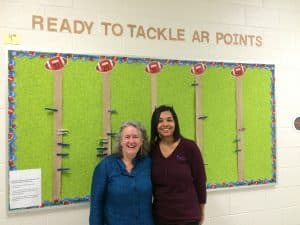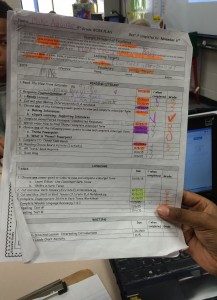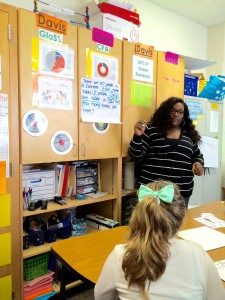Henry County Schools: What All of This Means for Schools
CompetencyWorks Blog

This post is part of a the series on Henry County, Georgia. This is the fourth of five posts. Read them all the way through: Post #1: Four Big Takeaways, Post #2: Ensuring Success for Each Student, Post #3: Scaling Strategies for Mid-Size Districts, Post #4: What All of This Means for Schools, Post #5: Impact Academy.
During my visit to Henry County Schools (HCS), we stopped off at two schools for conversations with principals and teachers about their experience to date. Luella Elementary, led by Carla Montgomery, is in the planning stage. The nearby Luella High School was in its fourth month of implementation.
Luella Elementary
Principal Carla Montgomery walked us to the fifth grade math classroom of Ms. Davis to provide an example of what she hoped their entire school might look like in a few years. As I watched students work independently, in small groups, at computers lined up against the wall, or with Ms. Davis, my first thought was that I was observing a station rotation model. However, as I talked to students and watched them change where they were working or the tools they were using to learn, I realized they were moving around as needed. Montgomery noted, “It seemed very chaotic at first, but Mrs. Davis continued working with kids, acclimating them to making decisions based on their learning needs, and now they know what is expected.”

Students have a great deal of choice about how they learn at Luella Elementary School. There were several products available to the students, including LearnZillion, First in Math, ST Math, and iReady, among others. They also had the choice to work without a device (there is a computer cart of devices for every grade level). For example, two groups of students were sitting on the floor practicing their multiplication through a card game. The tool that guided them in their activity was a workplan developed for each unit.
I was curious about how the students determined which method to use, and found that it often came down to preference – a few enjoyed working on the computer the most, many liked working with their friends, and a few liked working alone and without a computer.
As the next class entered the room, a number of students streamed over to Ms. Davis’ desk. I discovered that they used a website to sign up to meet with her at the teacher table before class.

Montgomery explained to me that she thinks of the school as an orchestra, with teachers at different levels and with different skills. Her job is to help teachers try new practices, build expertise, and direct people to someone else at just the right time to help them learn something new or fine tune their skills. She started with just small groups of teachers working together, such as the 4th-5th grade team of Ms. Davis and Ms. Davis, and now a majority of the teachers are working collaboratively to learn to better use project-based learning or manage a personalized classroom. Teachers are learning how to develop learner profiles, design units, create videos to deliver instructional mini-lessons, and manage variations in pacing. She explained, “I need to know my teachers, and the way I do that is through observation. From there I can help them to create personalized plans to build on their strengths.”
She explained that one of the big shifts she helps teachers understand is that working with students more and in-depth replaces the effort of trying to control students. She also emphasized that her job is primarily about managing the change and all the emotions that go along with it. “There is a lot of grief in letting go. It can cause stress if people just try to hold it all in. The job of the principal is to create the safety to fail.” She recommended three resources that have been helpful to her and her teachers around change management:
She noted that transparency plays a critical role in the change process. “When teachers collaborate, when they open their doors to each other, when they share their best practices, the levels of practice improve.” Karen Perry, Special Projects Coordinator at HCS, expanded on this with, “Competency-based learning is about getting everyone on the same page in terms of common high expectations of mastery. It allows teachers to work together to do their very best for kids.” Perry noted that Schoolworks had been very helpful in providing a classroom observation tool that draws upon what kids are doing as well as teaching instructors how to frame questions to students to better understand their learning process.
Luella High School
When a new high school opened and Luella High School (LHS) went from 2,400 students to 1,200, they had a chance to “hit the reset button.” The school is now 41 percent FRL. It is about 25 percent white, and 75 percent a mix of African-Americans and Hispanic.
The school is only a few months into implementation, with ninth and tenth grade teachers becoming familiar with the competencies and performance indicators as well as starting to design units based on Understanding by Design. Some are beginning to build rubrics or meeting together to look at student work. About 25 percent are at the stage of beginning to try out new practices. For example, I visited a group of three teachers who share several classes of ninth grade algebra students in order to offer a more flexible set of learning opportunities. Students could work on projects with one teacher, work on online content with another teacher, or receive direct instruction and tutoring from a third teacher. Online content was collaboratively built by the team and is available to all students as an on-demand resource.
One of the teachers explained that their structure is designed to catch anyone who needs help. Although student were initially grouped based on formative assessment data, students and teachers began collaboratively deciding which learning environment works best for each child. School staff are finding that students are more willing to let teachers know when they don’t understand because they know they will have a chance for more personalized tutoring. They are also finding that they need to develop their skills in formative assessment rather than simply grouping students. Teachers are working to move to collaborative grading or tuning to ensure that there is consistency of expectations built upon competencies.
The change process is led by Principal Jerry Smith, project manager Jennifer Gay, and personalized learning coach Gail Chapman. Smith explained that he was about to retire until this opportunity to create a personalized high school came up. “The focus in this school is on the students,” he said. “We have lost too many students, graduated them ill-prepared for their lives. We have lost some great minds because they became bored or bitter. We can’t do that for the next generation.”
The team at LHS have reconfigured how they construct honors. After asking the question “What is honors?” they began to parse honors courses. Gay explained, “We realized that it wasn’t more work, or faster. It was deeper learning, something all students should have access to.” They have since phased out honors classes and replaced it with honors contracts to do the extra work involved with going deeper on issues.
Among the tasks before them is creating a “21st century report card” that will clearly show progress on standards and separate out behavior. Smith explained that a faculty task force has created a set of behaviors that are important for success in the classroom, including conduct, effort, communication, task and time management, desire for deeper learning, respect, and empathy.
—
Our final post on Henry County Schools looks at a virtual school model at Impact Academy.